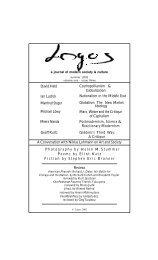Michael J. Thompson Stephen Eric Bronner Wadood Hamad - Logos
Michael J. Thompson Stephen Eric Bronner Wadood Hamad - Logos
Michael J. Thompson Stephen Eric Bronner Wadood Hamad - Logos
You also want an ePaper? Increase the reach of your titles
YUMPU automatically turns print PDFs into web optimized ePapers that Google loves.
Ali Hossaini<br />
explain the evolution of the optical media, particularly as it progresses toward<br />
the dematerialized realm of digital imagery and virtual reality.<br />
Much has already been written about virtual reality. Though the medium is<br />
not yet viable, it has ample precedents ranging from Plato’s Cave Passage to<br />
nineteenth century dioramas. The strongest precedent, however, is the virtual<br />
experience offered by photography and cinema, both of which derive, like the<br />
examples I just gave, from reflection upon optics. Whether or not it comes to<br />
pass, the idea of a virtual environment should serve as a boundary condition<br />
for photographic theory, because it illustrates the profound impact of optics<br />
on society. For most of its existence humanity has experienced the world<br />
through natural faculties, but the introduction of optical media has<br />
reorganized perception and replaced subjectivity. As a consequence,<br />
individuals have become part of increasingly larger collectives where both<br />
thought and experience are defined by objective standards. The environment<br />
has become mediated, defined by surveillance and institutions, and, as Jean<br />
Baudrillard has poignantly described, experience is often equated with media.<br />
The central issues in photographic theory are defined by the history of optics.<br />
The study of vision and light has an ancient pedigree which scholars have<br />
only nodded toward when discussing photography. Scientific optics matured<br />
by the 3rd century BCE, when Euclid codified its principles alongside its<br />
parent discipline, geometry. Organized as a set of formal principles, Euclid’s<br />
Geometry describes the construction of forms in an abstract space, giving their<br />
appearance to an ideal intelligence. In contrast, his Optics described the<br />
behavior of light in relation to a situated viewer. Taken together, the two<br />
works present a theory of how the physical world is constituted in reality and<br />
appearance, with the latter describing how light transmits information from<br />
the physical, geometric realm to the eyes.<br />
Euclid’s optical study represents a high point of knowledge that remained<br />
almost unmatched until the scientist Ibn al-Haytham published his optical<br />
treatises in the 9th century. 1 Building on the work of Euclid and his<br />
successor, Claudius Ptolemy, Al-Haytham founded physiological optics,<br />
which distinguished the functioning of the eye from the behavior of light. He<br />
also laid the groundwork for the camera obscura by accurately explaining the<br />
pinhole effect which underlies its mechanism. Several centuries later, well<br />
after al-Haytham’s Optics passed into Europe, the camera obscura emerged<br />
from the laboratory as a tool for artists, but it was not until the 1600s that<br />
Johannes Kepler discovered the proper operation of the eye. Much like a<br />
<strong>Logos</strong> 2.3 – Summer 2003




